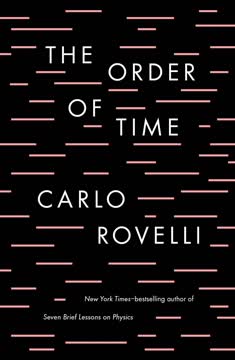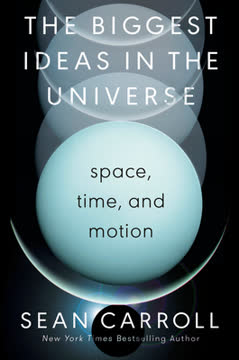Key Takeaways
1. Black Holes Are Fundamentally Empty Spacetime
Black holes are nothing.
Not dense objects. Contrary to popular belief, the essence of a black hole isn't a dense crush of matter, but rather a region of empty spacetime defined by its event horizon. While they can form from collapsing stars, the matter that created them is not the black hole itself. The black hole is the gravitational effect left behind.
Pure vacuum. A bare black hole is pure, empty spacetime, devoid of atoms, light, or particles. The original matter falls through the event horizon and is gone, leaving only the warped spacetime and its gravitational pull. This empty nature is what makes them peculiar and fascinating to physicists.
Mass without stuff. Black holes have mass and gravitational attraction, even though they are empty. This mass is the energy equivalent of the matter that collapsed or fell in, imprinted onto the spacetime curvature. They behave like massive objects, orbiting and interacting gravitationally, despite containing no physical "stuff" in the conventional sense.
2. Gravity Is the Curvature of Spacetime
Gravitation is curved spacetime.
Einstein's insight. Einstein's greatest realization was that gravity isn't a mysterious force pulling objects, but a manifestation of the curvature of spacetime caused by mass and energy. Objects in free fall, like planets orbiting the Sun or astronauts in orbit, are simply following the natural curves in spacetime.
Free fall is natural. When you are in free fall, you feel weightless because there is no force pushing against you; you are simply surrendering to the geometry of spacetime. What we perceive as gravity's pull is actually the resistance we feel when something, like a chair or the ground, prevents us from following our natural free-fall path.
Mapping curvature. We can map the curvature of spacetime by observing the paths of objects in free fall.
- Throwing a ball on Earth shows a curved path.
- Planets orbit the Sun on curved paths.
- Astronauts in the ISS follow a curved orbit around Earth.
These curved paths demonstrate that space around massive objects is not flat.
3. The Event Horizon Is the Point of No Return
The region beyond which not even light can escape.
Defining boundary. The event horizon is the boundary around a black hole where the escape velocity equals the speed of light. Anything, including light, that crosses this boundary is trapped forever, unable to return to the outside universe. This makes the black hole appear black from the outside.
Invisible threat. A black hole is invisible against a dark background. You might not realize you are approaching one until you are too close to escape. Crossing the event horizon of a large black hole would feel uneventful, like stepping into a shadow, but it seals your fate.
One-way membrane. The event horizon is a one-way membrane: things can fall in, but nothing can come out. Events inside the horizon cannot influence the outside world, but events outside can affect the interior. This causal disconnect is a defining feature of black holes.
4. Time and Space Warp Near Black Holes
Even time is relative.
Spacetime distortion. Black holes don't just curve space; they also warp time. As you approach a black hole, time slows down relative to observers far away. This effect, known as time dilation, becomes extreme near the event horizon.
Clocks disagree. If you paused your fall near a black hole while a friend stayed far away, your clocks would appear to run slower to them, and their clocks would appear to run faster to you. At the event horizon, your time would appear to stop completely to the distant observer, while your own clock would seem normal to you.
Future is inward. Inside the event horizon, the warping of spacetime is so extreme that the direction we normally call "time" points towards the black hole's center. Moving forward in time means moving inward towards the singularity, making escape impossible. The singularity exists in your future, not just at a spatial center.
5. The Singularity Is a Predicted End (or Problem)
Death by singularity is the paramount existential death—the death of your fundamental particles, the removal from reality of you and your constituent stuff.
Relativity's prediction. General relativity predicts that spacetime curvature becomes infinite at the center of a black hole, forming a singularity. This is where all infalling paths terminate, and matter is predicted to be crushed out of existence.
Physical destruction. If you fell into a black hole, tidal forces would stretch and compress your body mercilessly as different parts accelerate at different rates towards the singularity. You would be ripped apart and pulverized into elementary particles in microseconds.
Theory breaks down. Physicists suspect the singularity prediction indicates that general relativity is incomplete. At the extreme conditions inside a black hole, quantum effects likely become important, and a quantum theory of gravity is needed to describe what truly happens at the center, potentially replacing the singularity with a quantum remnant or other phenomenon.
6. Astrophysical Black Holes Are Engines of Light
The darkest astrophysical object in the universe, a veritable hole in space that emits no light, a black hole is transformed ironically into the engine for a light source that outshines any other in the universe.
Not always dark. While the black hole itself is dark, the intense gravity of astrophysical black holes often pulls in surrounding matter like gas and stars. This material forms a hot, swirling accretion disk that can become incredibly luminous, outshining entire galaxies.
Powering quasars. Supermassive black holes at the centers of galaxies can power quasars, the brightest objects in the universe. As matter falls into the black hole, magnetic fields can launch powerful jets of particles and radiation millions of light-years into space.
- Our Milky Way has a supermassive black hole, Sagittarius A*, but it is currently quiet.
- The black hole in galaxy M87 is billions of times the Sun's mass and powers a famous jet.
Indirect detection. We detect black holes indirectly by observing their gravitational effects on nearby stars and gas, or the light emitted by accretion disks and jets. The first image of a black hole's shadow (M87) was captured by the Event Horizon Telescope, showing the dark silhouette against the bright accretion disk.
7. Black Holes Evaporate via Hawking Radiation
Nothing can escape from a black hole, yet black holes emit Hawking radiation and thereby evaporate.
Quantum vacuum fluctuations. The vacuum of space is not truly empty but filled with quantum fluctuations, where pairs of virtual particles constantly pop into and out of existence. Near the event horizon, the intense gravity can separate these pairs.
Particle escape. If one particle of a virtual pair falls into the black hole, its partner outside the horizon can escape as real radiation, known as Hawking radiation. This radiation carries energy away from the black hole.
Mass loss. Because energy must be conserved, the energy carried away by Hawking radiation comes from the black hole's mass. This means black holes slowly lose mass and shrink over time, a process called evaporation. Smaller black holes evaporate faster than larger ones. This quantum effect suggests black holes are not entirely black.
8. The Black Hole Information Paradox Challenges Physics
The black hole magically made the information vanish.
Information conservation. A fundamental principle of quantum mechanics is that information is conserved; it cannot be destroyed, only transformed. This means the past state of a system can, in principle, be reconstructed from its present state.
The paradox. When matter falls into a black hole, its information seems to be lost behind the event horizon. If the black hole eventually evaporates via featureless Hawking radiation, which carries no information about what fell in, and then disappears completely, the information about the original matter is gone from the universe.
Conflicting principles. This apparent destruction of information conflicts directly with the conservation principle in quantum mechanics. The paradox highlights a deep incompatibility between general relativity (predicting information loss) and quantum mechanics (predicting information conservation). Resolving it requires a unified theory of quantum gravity.
9. The Universe Might Be a Hologram
The black hole, and please feel welcome to take a beat to accept this conclusion as a consequence of the argument, is a hologram—a two-dimensional encryption that projects a three-dimensional image.
Information on the boundary. To resolve the information paradox, some theories propose that the information about the black hole's interior isn't lost but is somehow encoded on the two-dimensional surface of the event horizon. This idea is inspired by the holographic principle.
Holographic principle. This principle suggests that the maximum amount of information contained within a volume of space is proportional to the area of its boundary, not its volume. This implies that our three-dimensional reality could be a projection of information stored on a distant, two-dimensional surface.
Duality theories. Mathematical discoveries have shown equivalences between theories with gravity in a certain spacetime (like anti-de Sitter space) and quantum field theories without gravity living on the boundary of that spacetime. This "duality" suggests that the two descriptions are of the same reality, supporting the idea that gravity and the dimensions we experience are holographic projections.
10. The Firewall Paradox Reignited the Crisis
The black hole information-loss conundrum remains unresolved, the peace shattered in a blazing firewall that even the proponents of the reanimated crisis lit with regret.
Entanglement constraint. Quantum mechanics requires that particles created together, like Hawking pairs, are entangled. The particle escaping the black hole must be entangled with the particle falling in. However, if information is also escaping in the Hawking radiation, later escaping particles must also be entangled with earlier ones.
Monogamy of entanglement. A particle can only be maximally entangled with one other system. If an escaping Hawking particle is maximally entangled with its partner inside the black hole, it cannot also be entangled with the earlier Hawking radiation that has already escaped and carries the interior's information.
The firewall. To satisfy entanglement requirements and information conservation, some physicists proposed that the event horizon is not a smooth, uneventful boundary but a high-energy "firewall" that destroys anything crossing it. This resolves the information paradox but violates Einstein's principle that falling into a large black hole should be smooth, reigniting the conflict between quantum mechanics and general relativity.
Last updated:
Review Summary
Black Hole Survival Guide receives mostly positive reviews for its engaging, accessible explanations of complex physics concepts. Readers appreciate Levin's clear writing style, creative analogies, and infectious enthusiasm for the subject. Many find the book both informative and thought-provoking, praising its ability to convey difficult ideas to a general audience. Some readers note that certain sections, particularly towards the end, become more challenging to follow. The book's brevity and occasional repetitiveness are mentioned as minor drawbacks. Overall, it's recommended for those interested in black holes and astrophysics.
Similar Books
Download PDF
Download EPUB
.epub digital book format is ideal for reading ebooks on phones, tablets, and e-readers.









